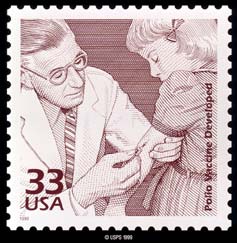Polio vaccine
|
|
Two polio vaccines are used throughout the world to combat polio. The first was invented by Jonas Salk and first tested in 1952 and announced to the world by Salk on April 12, 1955. It consists of an injected dose of killed polio virus. Albert Sabin produced an oral polio vaccine using live but weakened virus in 1962.
When the live-virus Sabin vaccine was developed, it spread in popularity for several reasons. First, it can "infect" other, non-vaccinated individuals with whom the vaccinated person has close contact and confer some immunity to them. Second, because the oral vaccine acts in the gut, it confers immunity there and reduces the spread of the wild virus. The injected vaccine, acting through the bloodstream, immunizes the individual but does not reduce his ability to spread the wild virus. Third, the live-virus vaccine is cheaper than the killed-virus vaccine. Finally, the oral vaccine is easier to administer than the injected vaccine, so patients are more likely to complete the vaccination series and attain full immunity. Though Salk's vaccine by 1962 had reduced the incidence of polio to a tiny fraction of what it was in the early 1950s, Sabin's vaccine was considered superior for these reasons and became the standard treatment. The killed-virus vaccine immunized people against the effects of the virus, but the virus could still spread from person to person. It was the live-virus vaccine that enabled the complete elimination of the wild polio virus in the United States.
The major disadvantage of the live-virus vaccine is that it can itself cause polio, and does so in about one in 2.4 million recipients. There is no such risk from the killed-virus vaccine. In the United States, once polio was eradicated within its population, the Centers for Disease Control decided that the slight advantages of the live-virus vaccine were not worth several vaccine-induced cases of polio each year. The use of the live-virus vaccine was discontinued after 2000, but it is still used elsewhere where polio remains a common threat.
The two vaccines have eliminated polio from most of the countries in the world and reduced early cases from hundreds of thousands per year to only 1000 worldwide in 2001.
Initial attempts to develop a vaccine were hampered by the difficulty of obtaining enough of the virus. Growing it in the brains of monkeys produced only small quantities. Rats were used later, but the breakthrough came in 1948, when John Franklin Enders, Thomas Huckle Weller, and Frederick Chapman Robbins developed a method for growing the virus in the laboratory. This breakthrough greatly facilitated vaccine research. Enders and his colleagues were awarded the Nobel Prize in Physiology or Medicine in 1954.
See also
External links
- PBS: Salk Produces Polio Vaccine (http://www.pbs.org/wgbh/aso/databank/entries/dm52sa.html)
- Vaccines for Development (http://blogs.cgdev.org/vaccine)

